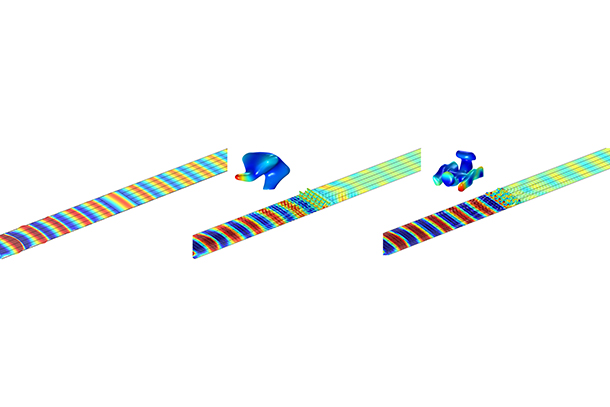
Researchers developed locally resonant metasurfaces composed of topology-optimized resonators. The resonators, shaped like an elephant (left) or a boat (right) match the correct density and frequency needed to stop surface waves from propagating beyond their barrier. Credit: Daniel Guzman/Penn State. All Rights Reserved.
Engineers design metasurfaces to help control surface wave propagation
The work has potential implications for wave control across length scales, researchers report
March 3, 2023
By Ashley WennersHerron
UNIVERSITY PARK, Pa. — Surface waves from earthquakes, explosions and other human activity can propagate out from an epicenter, wreaking havoc as they go. Controlling such waves could prevent damage and destruction. At much smaller scales, surface wave filtering and manipulation could induce desirable properties in miniature electronic devices. Now, Penn State College of Engineering researchers have used a strategic design approach called the topology optimization method (TOM) to design fabricated, patterned sheets with tunable properties — called metasurfaces — that control surface waves.
Led by Parisa Shokouhi, professor of engineering science and mechanics, the team published their results in JASA Express Letters, a journal of the Acoustical Society of America.
“Our multidisciplinary team designed a metasurface barrier made up of resonating — or vibrating — structures to stop plate waves from propagating into a specific area,” said corresponding author Parisa Shokouhi, professor of engineering science and mechanics. Metasurfaces are fabricated sheets with patterned structuresSurface waves are long-range and can travel far without losing much energy, but the metasurface barrier’s resonating structures can interrupt them. “Control of guided waves has applications across length scales from surface acoustic wave devices — used in electronics and non-destructive evaluation and structural health monitoring, such as inspecting pipelines — to seismic barriers.”
The resonating structures in this barrier are tuned to a specific frequency, matching the predefined target frequency of surface waves propagating across an aluminum plate. According to Shokouhi, the researchers formulated their design methodology as a topology optimization problem, using TOM. Aimed at generating a bandgap — a zone without propagation — around a specific frequency, the topology optimization method automatically designs resonators that are optimally shaped to have certain resonance and antiresonance characteristics. This results in what Shokouhi called locally resonant elastodynamic metasurfaces.
Credit: Daniel Guzman/Penn State.
This simulation demonstrates how a locally resonant metasurface comprising topology-optimized resonators shaped like elephants can stop surface waves.
“In this paper, we demonstrate that the methodology can design resonators for metasurfaces capable of suppressing plate waves, called Lamb waves, but this method can be extended to design resonant metasurfaces that can control other types of guided waves regardless of the frequency range,” Shokouhi said, noting it is the first time TOM — initially designed in the 1980s to solve structural design problems — has been applied in this way. “This systematic design strategy can be generalized further, presenting a potential approach for wave control in other areas, such as acoustics.”
Co-authors include Daniel Giraldo Guzman, first author on the paper and doctoral candidate in the Penn State Department of Mechanical Engineering, who won a first-place award for his presentation at the fall 2022 Acoustical Society of America conference. The other Department of Mechanical Engineering co-author is Mary Frecker, Riess Chair of Engineering, professor and department head. Co-authors from the Penn State Department of Engineering Science and Mechanics are Lalith Sai Srinivas Pillarisetti, doctoral student; Sashank Sridhar, graduate student who was an undergraduate when the paper was submitted; and Cliff J. Lissenden, professor of engineering science and mechanics and of acoustics.
The National Science Foundation supported this work, which stemmed from a College of Engineering Multidisciplinary Research Seed Grant to Shokhoui in 2017. The research computations were performed on Roar, a supercomputer housed in Penn State’s Institute for Computational and Data Sciences.



